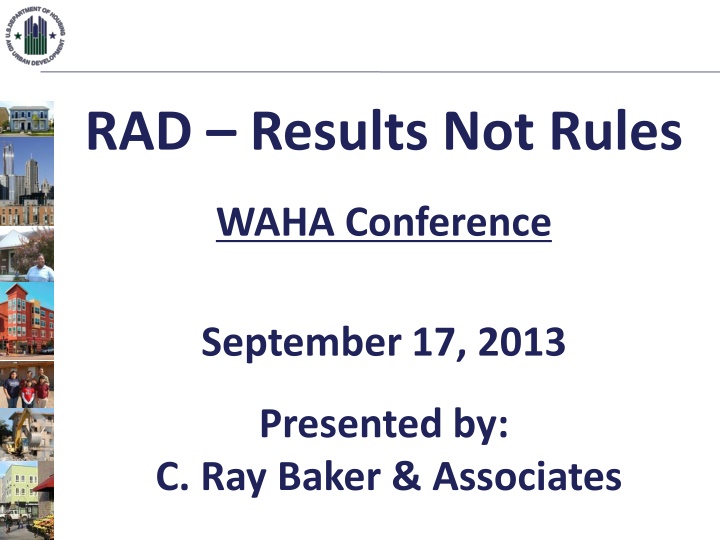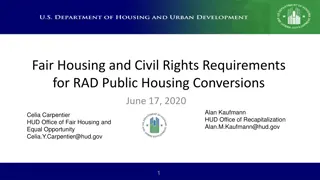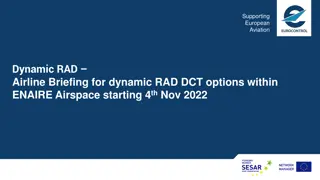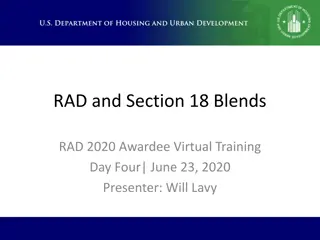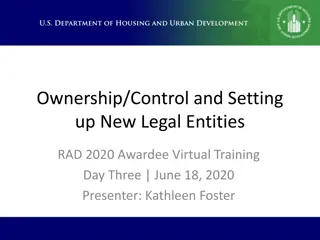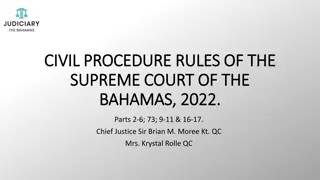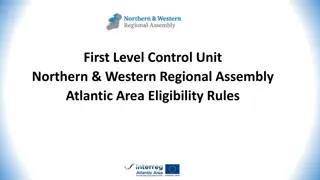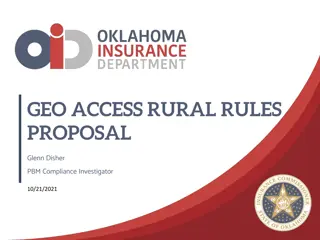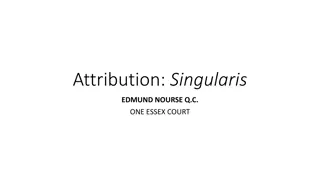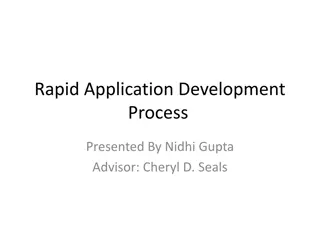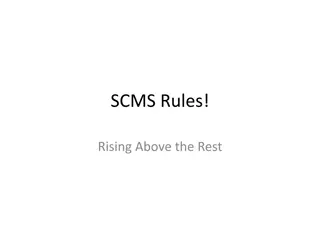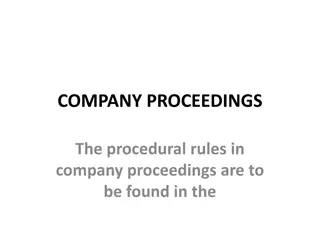RAD Results Not Rules WAHA Conference
C. Ray Baker & Associates presented at the RAD Results Not Rules WAHA Conference on September 17, 2013. The presentation highlighted the benefits and principles of RAD (Rental Assistance Demonstration) program, its impact on public housing authorities, and the comparison with the HOPE VI program. It also discussed RAD basics, eligibility criteria, and the secure funding model under Section 8. Key points included the types of developments possible under RAD, conversion process details, and the focus on tenant protections and affordable housing initiatives.
Download Presentation

Please find below an Image/Link to download the presentation.
The content on the website is provided AS IS for your information and personal use only. It may not be sold, licensed, or shared on other websites without obtaining consent from the author.If you encounter any issues during the download, it is possible that the publisher has removed the file from their server.
You are allowed to download the files provided on this website for personal or commercial use, subject to the condition that they are used lawfully. All files are the property of their respective owners.
The content on the website is provided AS IS for your information and personal use only. It may not be sold, licensed, or shared on other websites without obtaining consent from the author.
E N D
Presentation Transcript
RAD Results Not Rules WAHA Conference September 17, 2013 Presented by: C. Ray Baker & Associates
IS RAD FOR YOU? My objective is to: Be honest with you Give you the information to decide: About RAD Which Site Give you the tools to succeed Help you avoid mistakes 2
IS RAD FOR YOU? Be honest with yourself Do your homework Consider pooled procurements and transactions Assemble the best possible team Stay involved follow the program 3
RAD VS. HOPE VI In nine months there are more Public Housing Authorities and Public Housing Units committed to RAD than there were in the first two years of the HOPE VI program. The RAD program has not required any additional funding from Congress. Over 20 years Congress has spent $5.6 Billion on HOPE VI. 2/2/2012 4
RAD BASICS What is RAD? HUD demonstration program that combines public housing operating and capital subsidy into payments under a Section 8 HAP contract What kinds of developments are being done with RAD? Minor rehab; major rehab; new construction; mixed income; off-site replacement housing How do I determine if I have a project/portfolio that would be a good candidate for RAD conversion? Use the RAD Inventory Assessment Tool in the Resources section of www.hud.gov/rad How would RAD affect: Residents: No change; 30% of income for rent PHA Functions: Dependent on cash flow, fees, strong management; puts them on the more secure Section 8 funding platform; Gives them the affordable housing tools of other nonprofit developers Resources: www.hud.gov/rad; www.radcapitalmarketplace.com; www.radresource.net 5
RAD BASICS Contract Rents: Operating Fund (with Operating Fund Allocation Adjustment) + Capital Fund + Tenant Rents = RAD Contract Rent Can convert Public Housing to: Project-Based Rental Assistance (PBRA) or Project-Based Vouchers (PBV) Can only convert at current funding levels WHY IS THE SECTION 8 FUNDING MODEL MORE SECURE FOR A PHA? Tenant Protections: Tenants have the absolute right to return Choice-Mobility, with limited exemptions Extensive waiver authority available to facilitate conversion 6
PUBLIC HOUSING CONVERSION RENT LEVELS Sample Public Housing Conversion Per Unit Monthly (PUM) $900 $800 $700 Operating Fund $330 Housing Assistance Payment $474 $600 $500 $792 Capital Fund $144 $400 $300 $200 Tenant Tenant Payment $318 Payment $318 $100 $- Pre-Conversion ACC Post-Conversion Section 8 7
WHERES THE MONEY? The RAD options: Modest rehab with debt only Moderate rehab with debt and 4% LIHTCs Major rehab or replacement with debt and 9% LIHTCs These are funding sources that are not conveniently available to small PHAs A conversion of all LIPH units eliminates the HUD requirements for: Procurement Annual and Five- Year Plans PHAS REAC (if ) You Get to Keep the Money 8
THE RAD DETAILS Ownership Public or non-profit, except to facilitate tax credits The authority leases the land to the LIHTC Partnership A Physical Condition Assessment (PCA) must be performed on RAD sites to determine the improvements required The authority must comply with the Uniform Relocation Act An existing PILOT agreement must be renewed when ownership changes Davis-Bacon wages must be paid during rehabilitation 9
KEY CHANGESINTHE RAD NOTICE Mixed Finance projects Removes unit cap for Mixed Finance projects Allows financially distressed HOPE VI projects to apply Exempts awarded projects from the Public Housing Assessment System (PHAS) Extends Capital Fund obligation and expenditure deadlines Clarifies conditions for rehab assistance payments Notes: HUD will honor the FY 2012 RAD contract rents for all applications received before end of CY 2013 (applies to individual applications, portfolio awards, and multi-phase awards) PHA may adjust Contract Rents across multiple projects as long as aggregate subsidy does not exceed current funding ( rent bundling ) 10
KEY CHANGESINTHE RAD NOTICE Eliminates caps on units that can convert for: Public housing Mode Rehab Creates new awards for: Portfolio conversions PHA defines portfolio of projects, either the entire PHA inventory or some subset PHA must submit applications for at least half of the projects in portfolio HUD will reserve award for remaining units in portfolio PHA must submit application for remaining projects in portfolio within 365 days Multi-phase conversion Allows PHAs to reserve conversion authority for projects with multiple development phases with applicable contract rent for all phases PHA has until July 1, 2015 to submit application for final phase PHA required to fulfill all CHAP milestones for each CHAP awarded Upon application acceptance, HUD will issue CHAP for initial phase and multi-phase award letter covering all phases of project Joint RAD/CNI applicants 11
WHY RAD? What Makes RAD So Special? One simple application, not four long ones. Not competitive, just get it right. Rapid turnaround by HUD. Less procurement, fewer specialized consultants. High probability of approval. How high? RAD brings in new money. 12
THE RAD PROCESS What Makes RAD So Special? Board Approval Site Selection Tenant Meetings Non-binding letters from lenders and LIHTC investors Submit the application Can the Authority stop the RAD process? 13
CONVERSION STEPS PUBLIC HOUSING HQ issues awards/Commitments to Enter Housing Assistance Payments Contract (CHAPs) PHAs submits Excel-based Application to HQ HQ reviews application and requests Field Office input on Eligibility HUD Publishes Final Notice PHAs have 6 months to submit Financing Plan to HQ for review PHA Asset Management Subsidy Administration PBV Project converts Remove from ACC Release DOT Execute HAP Execute RAD Use Agreement Close Financing PIH Voucher Oversight HUD issues RAD Conversion Commitment Multifamily Housing Asset Management Subsidy Administration PBRA 14
THEAPPLICATION Simple, start with basic pro forma www.hud.gov/rad Application Two resident meetings Board meeting and approval Financing letters Lender Investor If 9% credit, letter from HFA or self-scoring Choice Mobility: Letter for PBRA; ability to administer for PBV If converting a project that is currently mixed-finance, need signatures of all parties Fix Fatal Error issues CHAP Award 15
CLOSING PROCESS - MILESTONES Post CHAP DAY 1: CHAP Issued; Transaction Manager assigned DAY 30: Information on Development Team ( One Round allowance for LIHTC; schedule subject to oversight by TM) DAY 60: Firm Financing Letters DAY 180: Submit Financing Plan DAY 360: Closing and Conversion; Section 8 begins to fund Post Conversion Temporary Relocation (if necessary) Demolition (as necessary; no Section 18 approval required) Rehabilitation or New Construction Re-occupancy 16
YOUR AUTHORITY What are your key decision points? Which sites: Least rehab Most rehab Debt Only? LIHTCs: 4% 9% PBRA or PBV? 17
WHICH SITE FIRST? Do you select the site that: Needs the most work Can be converted with modest improvements Can be converted with no improvements If you do your RADomatic sites first what about PHAS Please consider a Portfolio Application Please consider Pooled Procurements Lobby WHEDA 18
TENTHINGS 1. Contract Rents Referred to as current funding Amounts can be found in: RAD Inventory Assessment Tool (rows 71-74 of the Inventory Overview Tab), and RAD Application (rows 5-7 of the Validation Tab) Based on 2012 funding levels: 2012 Tenant rents (from subsidy worksheet) 2012 Capital Fund Grant Award, by project 2012 Operating Subsidy Eligibility, assuming 95% proration (i.e., we restored the Operating Fund Allocation Adjustment ), excluding Asset Repositioning Fee (a special fund for demo/dispo projects) Current funding may be affected by PBV or PBRA rents caps, which are sensitive to estimated market (reasonable) rents Inventory Assessment Tool estimates market rent by using typical voucher rents (93% of FMR) RAD rents will be inflated beginning in 2014 using OCAFs (Operating Cost Adjustment Factors) OCAFs apply for both PBRA and PBV 19
TENTHINGS 1. Contract Rents (cont.) RAD contract rents reflect whatever utility arrangements are in effect at the project. Project-paid utilities -- RAD rents equal Gross Rents Tenant-paid utilities RAD rents plus utility allowance equals Gross Rents Inventory Assessment Tool uses average utility allowance (data was not available by bedroom size) RAD rents reflect any existing Energy Performance Contracts (EPCs) If project has an EPC where HUD has allowed a freezing of the project-paid consumption baseline, or an energy add-on , those arrangements will be carried over in RAD During the remainder of the initial calendar year of funding, the project receives only what it would have received under the public housing program (i.e., it carries forward all remaining Operating and Capital Funds for that year) If a PHA changes the bedroom distribution, the contract rents will be adjusted accordingly. Under public housing funding formulas, operating subsidies increase with each increase in average bedroom size (and decreases in each decrease in average bedroom size) For partial conversions, just enter the proposed number of units, and bedroom mix, and both the Tool and Application will show the new contract rents 20
TENTHINGS 2. PBVs vs. PBRA See accompanying chart of differences between PBV and PBRA Election depends on many factors 3. Choice-Mobility Applies to all conversions unless project has received an exemption Exemption available to: (1) public-housing only PHAs, and (2) PHAs that currently provide a preference in their voucher programs for homeless and vets if such preferences account for more than 33% of voucher turnover. Exemptions are granted based on first-come, first-served basis Requirements: PBV first available voucher after one year PBRA first available voucher after two years; however, PHA may also limit Choice-Mobility to not more than 15% turnover in any year and not more than 33% of voucher turnover in any year In all cases, assistance remains with the project. The mobility voucher comes from the agency s voucher turnover 21
TENTHINGS 4. Right to Return and Relocation All existing residents have a right to return to the RAD project, including Transfers of Assistance. There is no RAD requirement to retain the same bedroom mix or building type; however, a PHA must still meet the right to return requirement when making changes in bedroom mixes Residents may voluntarily waive their right to return a PHA may offer, for example, a turnover voucher or a unit in public housing To assist with relocation, HUD will make Rehab Assistance Payments for units under rehab or construction, equal to current subsidies, for all units receiving subsidy at the time of conversion. As a result, HUD does not provide Tenant Protection Vouchers (TPVs) for RAD and all other relocation expenses must be addressed in the Development Budget If relocation must last for more than one year, the family is considered to be permanently relocated under the Uniform Relocation Act (AC) and the PHA must find the family comparable assisted housing , which can include public housing or vouchers. While these resources will satisfy the URA, the family must still be given the right to return to fulfill RAD requirements (if not voluntarily waived) 22
TENTHINGS 5. De Minimis Reductions and Transfers of Assistance PHA must replace 95% of all units at project converting, with exceptions for units vacant for more than two years, to facilitate social service delivery, or for reconfiguring efficiency apartments. PHA can rehab, tear down on site and build new construction on or off- site PHA can also acquire/transfer the assistance Projects meeting RAD de minimis requirements do not need to seek separate approval from the Special Applications Center (SAC) to demolish or dispose of the project (exempt from so-called Section 18 ). PHA may, however, apply to the SAC for demo/dispo for a portion of the project All conversions must still meet right-to-return requirements 23
TENTHINGS 6. Public Housing Mixed-Finance Projects (i.e., projects developed under 24 CFR part 941, subpart F) To convert to RAD, both the PHA and the mixed-finance ownership entity must agree HUD will fund the project at the established RAD contract rent (or some other amount if the PHA is bundling projects); however, the PHA and ownership entity can decide how those funds are split (say, a new lease payment), provided the deal is considered feasible There is no limit to the number of mixed-finance projects (other than HOPE VI projects) that can convert The PHA and the ownership entity will need to unwind the mixed-finance project (1) the Declaration of Restrictive Covenants, (2) mixed-finance ACC, and (3) the Regulatory and Operating (R&O) Agreement. HUD recommends that the R&O be replaced by a streamlined regulatory agreement. Projects that are currently being developed under Faircloth may not be eligible for RAD if those projects are not currently receiving assistance under public housing (however, HUD is looking at the possibility of a joint closing process down the road) 24
TENTHINGS 7. Program Funds and De-federalization There is no restriction on use of cash flow (and no residual receipts account), mortgage proceeds, or developer fees PHAs are bound only by State and local laws, as applicable Unless the project is the remaining project to convert in a PHA s inventory, there will be a subsidy layering review where the PHA contributes Capital Funds to the Development Budget or where the PHA contributes public housing operating reserves in excess of the three-year average of reserves for the project All proceeds from seller-take back financing related to LIHTC transactions is also de-federalized. 8. Public Housing-only PHAs If convert to PBV, must find a voucher administrator willing to administer the PBV contract (that voucher agency will earn new admin fees) If convert to PBRA, will need to request Choice-Mobility exemption (or otherwise find a voucher agency willing to provide Choice-Mobility) 25
TENTHINGS 9. Projecting Operating Costs If estimating Operating Costs as a percentage of current Formula Expenses (say, 95%), keep in mind that Formula Expenses , as defined, within the Inventory Assessment Tool, exclude funding the PHA may receive under Stop-Loss (called Transition Funding ) If estimating Operating Costs based on historical project expenses, remember that HUD s public housing financial reporting model (1) has a slightly different chart of accounts than FHA and (2) has a separate column for Operating Fund and one for Capital Fund. Generally, you will want to include only the Operating Fund column 10. Resident Participation Remember to include two meetings with residents of the project prior to submitting an application (a PHA can combine more than one project at each meeting, as long as residents are notified accordingly) Remember to have one meeting with residents after RAD award (and prior to submission of Financing Plan) The PHA will also be required to submit a Significant Amendment to its Annual Plan, which also has public notice requirements 26
TENTHINGS 11. Bonus RAD Physical Condition Assessment (RPCA) Required only after CHAP award Exclusions for: new construction, for rehab that is down to the stud , and for projects recently built (based on HUD approval) HUD shortly to form user group 12. Bonus Ownership Type Ownership can include: PHA, directly or through related non-profit Any other public or non-profit owner For-profit owner in the case of tax credits No approval required of these alternate ownership arrangements (other than 2530/APPS process) 27
Various Considerations in Choosing PBRA vs. PBV Item 1. Baseline Funding Levels PBRA PBV Based on 2012 levels, with Operating Fund Allocation Adjustment restored 20 years Same 2. Initial Contract Term 15 years (up to 20 at option of voucher agency); voucher agency may also automatically extend for another 15 years Same 3. Contract Renewals At end of contract term, Secretary must offer, and PHA must, accept renewal Current funding cannot exceed 120% of the FMR, unless the current funding is less than market, in which case the current funding cannot exceed 150% of FMR. Based on Operating Cost Adjustment Factor (OCAF), i.e., the method used to adjust rents for Multifamily projects renewed under the Multifamily Assisted Housing Reform and Affordability Act (MAHRAA). Resident may request next available voucher after two years; however, voucher agency may limit to not more than 15% of project in any year and not more than 33% of voucher turnover due to RAD. N/A 4. Rent Caps Current funding cannot exceed the lower of (1) reasonable rent or (2) 110% of FMR. 5. Annual Inflation Adjustment Same 6. Choice Mobility Resident may request next available voucher after one year, with no limitations. 7. Voucher Admin Fee PHA earns Section 8 voucher admin fee for all units converted to PBV. Note: for agencies that do not administer a voucher program, and that convert to PBVs, the voucher agency will be responsible for administration of the waiting list, eligibility, reexaminations, leading to substantial deregulation for the converting agency. 28
Various Considerations in Choosing PBRA vs. PBV 8. REAC/UPCS Inspections Yes No (unless project receives FHA insurance) No (unless project receives FHA insurance) 9. REAC/FASS-MF Annual Financial Statements 10. Management and Occupancy Reviews (MORs) 11. Cash Flow 12. Appropriations Yes Yes No (unless project receives FHA insurance) Unrestricted Annual funding subject to appropriations; however, the Congress has never failed to renew a PBRA contract Same Annual funding subject to appropriations. Because of the RAD Use Agreement, if Congress provides less than full funding for the Voucher program (i.e., proration), the PHA administering the voucher program may will likely need to absorb the cuts from its non-RAD voucher units. 13. Rehab Requirements There is no required level of rehab under RAD (or requirement to leverage debt). The PHA must simply ensure that whatever needs are identified are addressed. Same 14. FHEO Site/Neighborhood Standards 15. Income Mixing Standard FHEO requirements not waived under RAD. N/A Same Under normal PBV rules, not more than 25% of units in a project can be assisted, unless the units are elderly or disable, scattered site, or receiving supportive services. RAD increased the threshold to 50%, with the same exceptions. (see pages 30-41 PIH 2013- 32 REV. 1) 29
PUBLIC HOUSING CONVERSIONS Resident Provisions No Re-Screening of Residents at Conversion One-for-One Replacement Must convert all or substantially all units in covered project Family Self Sufficiency Current FSS participants continue in program Resident Participation & Funding PHA must recognize legitimate tenant organizations PHA must provide $25 per occupied unit annually for resident participation ($15 per occupied unit > legitimate tenant organization Resident Procedural Rights Consistent with Section 6 of the 1937 Housing Act Resident Relocation Consistent with Uniform Relocation Act 30
WISCONSIN PHAS 31 SAUK CITY HA 32 LADYSMITH HA 33 PESHTIGO HA 34 SAUK COUNTY HA 35 ASHLAND COUNTY HA 36 FOND DU LAC HA 37 CHILTON HA 38 BRUCE HA 39 Boscobel HA 40 SLINGER HA 41 STANLEY HA 42 PLYMOUTH HA 43 MAUSTON HA 44 RHINELANDER HA 45 BARABOO CDA 46 AMERY HA 47 HUDSON HA 48 FREDERIC HA 49 HURLEY HA 50 SPARTA HA 51 SOUTH MILWAUKEE HA 52 RICHLAND CENTER HA 53 THORP HA 54 TREMPEALEAU HA 55 CLINTONVILLE HA 56 JEFFERSON HA 57 LAKE MILLS HA 58 NEW LONDON HA 59 WAUSAUKEE HA 60 KAUKAUNA HA 40 40 40 40 40 43 44 45 46 49 50 50 50 50 50 51 51 53 54 58 60 60 60 60 61 62 63 63 65 71 61 RIVER FALLS HA 62 WEST BEND HA 63 OCONTO HA 64 MARINETTE HA 65 WATERTOWN HA 66 ANTIGO HA 67 MONROE HA 68 Winnebago HA 69 DANE COUNTY HA 70 DEPERE HA 71 MERRILL HA 72 MANITOWOC HA 73 EDGERTON HA 74 EAU CLAIR HA 75 MENOMONIE HA 76 LACROSSE HA 77 RICE LAKE HA 78 VIROQUA HA 79 BELOIT HA 80 SHAWANO HA 81 ASHLAND HA 82 WISCONSIN RAPIDS HA 83 SHAWANO COUNTY HA 84 GREEN BAY HA 85 MARSHFIELD HA 86 Appleton HA 87 SHEBOYGAN HA 88 FOND DU LAC HA 89 STEVENS POINT HA 90 WAUKESHA HA 71 73 75 76 80 85 86 86 86 100 102 102 105 111 123 128 129 130 131 146 169 195 202 204 209 210 240 249 253 264 1 RACINE COUNTY HA 2 LUCK HA 3 EAU CLAIRE COUNTY HA 4 GREENWOOD HA 5 PULASKI CDA 6 Lincoln County HA 7 Brillion HA 8 WOODVILLE HA 9 MONDOVI HA 10 REEDSVILLE HA 11 CUMBERLAND HA 12 TOMAH HA 13 LAFAYETTE COUNTY HA 14 GRANTSBURG HA 15 Barron HA 16 Abbotsford HA 17 Chetek HA 18 SHELL LAKE HA 19 OSCEOLA HA 20 ALBANY HA 21 Burnett County HA 22 PARK FALLS HA 23 WESTBY HA 24 ALTOONA HA 25 WASHBURN HA 26 DEFOREST HA 27 ALGOMA HA 28 SPOONER HA 29 NEW RICHMOND HA 30 PRAIRIE DU CHIEN HA 8 16 16 20 20 20 24 26 26 27 27 28 28 29 30 30 30 30 30 32 32 35 35 36 36 36 39 40 40 40 31
WISCONSIN PHAS 91 WAUSAU HA 92 Oshkosh HA 93 Superior HA 94 LA CROSSE HA 95 MADISON HA 96 MILWAUKEE HA 344 410 465 593 743 3874 32
YOUR AUTHORITY 2002 CF $106 266 2012 CF $ 74,993 Decrease $ 31,273 29.4% WI085000002 OPFund Antigo Housing Authority $105,681 74,993 34
YOUR AUTHORITY Langlade County FMR 35
IS YOUR SITE IN A QCT? http://209.48.228.153/qctmap.html http://209.48.228.153/qctmap.html 36
PUBLIC HOUSING RESOURCES & TOOLS Determining a PHA s RAD Rent www.hud.gov/rad Resources PHA Conversion Guide RAD Inventory Assessment Tool Fill in PHA # Populate Fill in basic financing assumptions Top rent in BOLD is RAD rent Feasibility with debt only Feasibility with 4% LIHTC & 9% LIHTC 37
FHA MULTIFAMILY MORTGAGE INSURANCE Section 223(f) Refinance or acquisition Minor/moderate repairs ($6,500/unit*high cost factor) Permanent debt with repair escrow - up to 35 years Section 221(d)(4) Substantial rehab: 2 major building systems Construction/permanent debt all in one - initial/final closing 40-year financing Mortgagee Letter for RAD Transactions issued 10/12 Eligibility, underwriting criteria, processing & materials 41
FHA LIHTC PILOT PROGRAM Streamlined-Enhanced FHA 223(f) & LIHTCs Rehab expenditures of up to $40,000/unit Tax credit or Bond Cap allocation in hand Processed in Multifamily Hubs Using MAP lenders approved for the Pilot Goal of 3-4 month turnaround on applications 42
FEDERAL HOME LOAN BANK AHP Affordable Housing Program (AHP) This program is funded with 10% of the Federal Home Loan Banks' net income each year. Most effective when paired with other programs and funding sources, like Low-Income Housing Tax Credits. More than 776,000 housing units have been built using AHP funds, including 475,000 units for very low-income residents. $4.6 billion in total AHP dollars since 1990. That s 200 million per year. AHP loan funding often comes with an equal amount of grant funding. 43
RAD & LIHTCS RAD Sweet Spot Debt Only Abt study $24k/unit average capital need Opex at $4,500 pupy + $300 replacement reserves FHA debt at 3.45%; 1.2 DCR Feasible with RAD rents above ~$610/month 44
RAD & LIHTCS RAD Sweet Spot 4% LIHTCs Rehab needs above $24k/unit to ~$40k/unit Ease of meeting 50% test with RAD rents Available P-A Volume Cap Non-competitive QAPs favoring preservation, green Evolving, accessible short-bond structure Historically low borrowing rates 45
RAD & LIHTCS RAD Sweet Spot 9% LIHTCs Targeted prospects for substantial rehab & replacement housing No Section 18 review Income mixing Split project (AMP) 9% LIHTC used to help cover relo/demo/first phase 4% LIHTC for balance of site RAD HAP contract(s) for off-site replacement Acquisition/rehab New construction 46
RESULTSOFTHECOMPETITIVEROUND Initial Public Housing Awards Total applications: 113 Total awarded public housing projects: 110 Total awarded PHAs: 68 Total awarded Public Housing Units: 11,910 PHA Size* 32% Small (<250 Units in Inventory) 52% Medium (251-1,249 Units in Inventory) 16% Large (1,250+ Units in Inventory) *Based on 68 awarded PHAs 47
RAD ACROSSTHE COUNTRY 1ST COMPONENT Northeast Midwest South West Total PHAs and Mod Rehab Units Awarded 949 1,279 9,997 2,556 14,781 949 Units 1,279 Units 2,556 Units 9,997 Units 48
RAD AWARDS TREND CHART 160,000 Aggregated Number of Unit Awards Issued 140,000 Awards-to-Date 120,000 100,000 Awards Expected Based on Application Trends 80,000 Awards Expected Based on Current Outreach 60,000 40,000 Anticipated Future Awards 20,000 0
RAD CAPITAL MARKETPLACE www.radcapitalmarketplace.com 50
